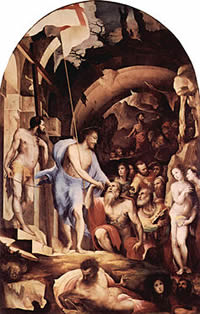Difference between Limbo and Purgatory
Key Difference: Purgatory is the place where souls are prepared for Heaven. The Limbo of doctrine was introduced by philosopher Augustine, who claimed that children who are not baptized are consigned to hell.
 Limbo and purgatory are two places that are commonly heard of in movies and books as places that are between heaven and hell. However, they are often confused to be the same thing. This is not accurate as limbo and purgatory are two different ideologies and concepts.
Limbo and purgatory are two places that are commonly heard of in movies and books as places that are between heaven and hell. However, they are often confused to be the same thing. This is not accurate as limbo and purgatory are two different ideologies and concepts.
Let’s start at the beginning. According to a doctrine produced by the Catholic Church, there is no official place known as Limbo. However, purgatory exits as a process rather than a place. Medieval theologians of Western Europe, suggested a place where the underworld was divided into four distinct parts: Hell of the Damned (also known as Gehenna), Purgatory, Limbo of the Fathers or Patriarchs, and Limbo of the Infants.
As per this division, there is hell where souls that die with sin are placed. Purgatory is the place where souls are prepared for Heaven. The Limbo of doctrine was introduced by philosopher Augustine, who claimed that children who are not baptized are consigned to hell. This continued for 800 years, until Monk Thomas Aquinas claimed that Limbo of Children is a state of natural happiness for unbaptized children.
According to the United Church of God, Limbo, from Latin limbus meaning edge or boundary (of hell by implication), was thereafter taught to be a state after death in Roman Catholic theology. It was compartmentalized into two categories, one for children called limbus infantium and the second for the Fathers called limbus patrum, a temporary state of the souls of anciently righteous people.
 Purgatory is considered to have a similar place but can be considered as a state where ‘purification’ occurs. According to the doctrine, Heaven is a place where there is no sin. So, people who have committed sins but atoned for them are consigned to Heaven. However, even if they have apologized for their sin, they have yet to pay the price or the dues to the people that the sin have hurt. So, these people remain in purgatory in order to be punished for their sins. At the time of judgment, the people who have paid for their sins will enter Heaven and people who have a lot of sins will be assigned to Hell.
Purgatory is considered to have a similar place but can be considered as a state where ‘purification’ occurs. According to the doctrine, Heaven is a place where there is no sin. So, people who have committed sins but atoned for them are consigned to Heaven. However, even if they have apologized for their sin, they have yet to pay the price or the dues to the people that the sin have hurt. So, these people remain in purgatory in order to be punished for their sins. At the time of judgment, the people who have paid for their sins will enter Heaven and people who have a lot of sins will be assigned to Hell.
Now, limbo is more a place that is divided into two: Children and Adults. As stated above, the limbo for children is for children who die that have not been baptized. Since, it is not in their hands, it is believed that they should not have to pay for it. So, they enter a happy place known as limbo for children. On the other hand, limbo for adults is a place for souls that have been excluded from heaven through no fault of their own. Limbo of the Fathers (Limbus patrum) is the place where people remain died before Christ, were detained until Heaven, which had been closed in punishment for the sin of Adam, was reopened by the Savior, Jesus Christ. When, Jesus died he entered Limbo and freed all those people before he was resurrected.
Because of the confusion regarding Limbo and Purgatory, on April 22, 2007 the Pope authorized the Roman Catholic Church to rule out limbo. So, children who are not baptized are now believed to enter heaven.
Comparison between Limbo and Purgatory:
|
|
Limbo |
Purgatory |
|
What is it? |
A place |
A process |
|
Definition |
A place where children who are not baptized reside |
A place where people must atone for their sins |
|
Baptization |
Unbaptized children |
Baptized people |
|
Catholic Doctrine |
Not part of the Catholic doctrine |
Part of the catholic doctrine |
|
Other meaning |
A dance that uses a stick and the people are expected to dance underneath it without touching the stick |
A place between heaven and hell (according to popular movies) |
Image Courtesy: wikimedia.org, catholicbridge.com









Add new comment